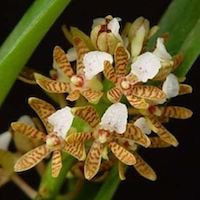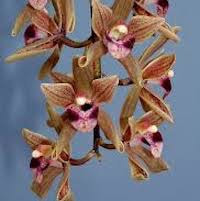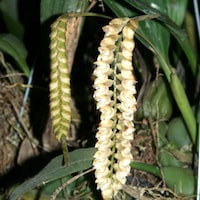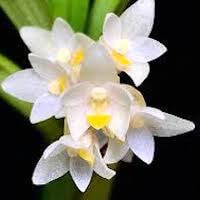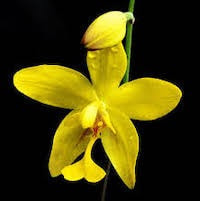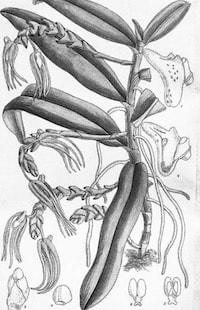WC4 - Women's Citrus 4 - The secret Citron
|
Native Singaporean Orchid notes: Cymbidium golden Elf
This orchid is praised on Npark's website for its beauty and easy maintenance. Known for its golden-yellow color and abundant blooming, it's highly recommended for collections. Its scent blends lemon and yuzu, evoking a refreshing morning aroma. The flower's bright yellow hue matches its delightful fragrance.
|
Therapeutic Orchid notes:
|
Acampe praemorsa
Also known as Rasna, derived from the roots of A. praemorsa, this bitter tonic is famous in India for treating rheumatism. It's also used for conditions like sciatica, neuralgia, syphilis, and uterine disorders. The Dongria Kandha tribe in Niyamgiri Hills takes a tablespoon of A. praemorsa root extract twice daily on an empty stomach for 15 days to ease arthritis. The Koya tribe in Andra Pradesh makes a paste of the plant with egg white and calcium, applying it on fractured limbs for healing. In Nepal, powdered A. praemorsa root treats rheumatism and cools. Acampe praemorsa contains natural compounds like flavidinin and praemorsin. |
|
Cymbidium devonianum Paxton
Fu Lan, known as Thir gava in Nepali and Gam ngu sac in Vietnamese, grows on mossy rocks and trees across Nepal, Bhutan, Bangladesh, Yunnan, Myanmar, Thailand, and Vietnam. In Nepal, it is valued for its medicinal properties: the root paste is applied to treat boils, and the plant is boiled down to make a tea. This tea is consumed three times daily to alleviate symptoms of coughs and colds. The plant's widespread distribution and traditional use highlight its importance in local herbal remedies across different cultures and regions. |
|
Pholidota imbricata Hook. f.
Pholidota imbricata Hook. f. is an orchid that grows with a creeping root and closely spaced, egg-shaped bulbs. It's found across regions from southwest China to Australia, including Sri Lanka and Southeast Asia. In Sri Lanka, it often grows on trees and rocks in moist areas up to 1200 meters high. In terms of its chemical makeup, scientists have isolated imbricatin from this orchid, which helps fight bacteria. Another compound, coelonin, has also been identified. Locally, people on the Malabar Coast use its roots to reduce fever and apply the entire plant on the lower back to help with childbirth and menstrual flow. The fruit and bulbs are used to treat ulcers, prepare tonics, and relieve rheumatic pain in various countries like Nepal and Bangladesh. |
|
Pinalia spicata (D.Don) S.C. Chen & J.J Wood syn. Eria spicata (D. Don) Hand.- Mazz.
Pinalia spicata (D.Don) S.C. Chen & J.J Wood, also known as Mihuaping Lan in Chinese, contains several chemicals like nudol, erianthridin, sitosterol, erianol, and a type of fatty alcohol that hasn't been fully identified. In Nepal, people dry the plant's stems, grind them into powder, and take it for stomachaches. They also make a paste from the stems to apply on the head for headaches. |
|
Spathoglottis affinis de Vriese Syn. Spathoglottis lobii Rchb.f.
This is a small yellow orchid found in Burma, Thailand, Peninsular Malaysia, and Java. It's becoming rare, especially in Gunong Jerai in northern Malaysia.In Thailand, people use the orchid's pseudobulbs to treat abscesses. Historically in Indochina, it was used for healing war wounds and infected wounds. |
|
Thrixspermum pardale (Ridl.) Schlecht. Also Sacrochilus pardalis, Ridl., Dendrocolla pardalis (Ridl) Ridl.
This plant is found in Sumatra, Peninsular Malaysia, and Borneo, growing at around 1000 meters above sea level in Sumatra. In Peninsular Malaysia, it often grows on trees in Perak and Pahang. For herbal use, its leaves are made into a paste to treat nose ulcers. Known as a Fragrant Orchid, its flowers smell like European Meadowsweet. The strong scent comes from chemicals like cis-linalool oxide and nerolidol, mixed with (E,Z)-2,4-decadienal, ethyl(Z)-4-decenoate, ethyl (E,Z)-2,4-decadienoate, and their (E,E)-isomers, along with gamma-decalactone. These same chemicals give Bartlett pears their distinctive aroma. |
Other scent note
Litsea cubeba, Osmanthus, orange, sweet lime, pink grapefruit, passion fruity, sweet orange, grapefruit, lime and Neroli
Scentopia Library Reference ingredient
Lemon- Singapore plants - Check details at Scentopia's scent library
Download the guided mediation that works best with this Orchid fragrance oil
| women_citrus_essential_oil_orchi_00004.mp3 | |
| File Size: | 172388 kb |
| File Type: | mp3 |

